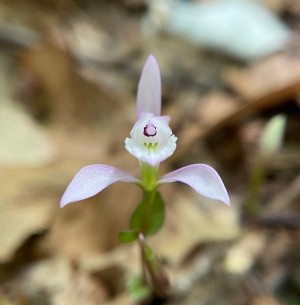August ushers in the season of satiety, an interval of repose. Botanically speaking, it is what I refer to as the “Lammas-time lull,” a dip in the calendar of bloom when the plant world seems to have accomplished the bulk of its summer work. The canopy has grown to one continuous mass of dark green leaves, sedges have shed their fruits, and spring ephemerals have faded into the background. Reliably at this season, a spate of chilly nights – what some folks call “sleeping weather” – brings a reprieve from the heat and also provides an environmental cue to one of our most elusive forest wildflowers: Triphora trianthophoros, the three-birds orchid.
I first met this plant, also known as nodding pogonia, by accident one late August day. I was walking in the deep shade of a mixed hardwood forest, not thinking of wildflowers at all. I turned onto an old logging road running cross-slope, and that’s when I saw them: a swath of tiny plants growing in the middle of the path. Then I noticed dozens, hundreds more, uphill and down. The diminutive flowers, just 10 to 15 millimeters long, had a pinkish hue and actually shimmered in direct sunlight. Some writers suggest that the flowers, often three to a plant, look like birds in flight, but to me they looked like nestlings with their beaks open, waiting for their next meal.
Three-birds is a forest orchid that grows in full shade, receiving light only from occasional sunflecks. Its typical habitat in the Northeast is northern hardwood forest, but tree composition at sites I’ve visited has been variable. Sugar maple has been the one consistent associate (not beech, as some field guides assert). The natural range of three-birds covers most of the eastern United States, as well as Ontario, so it is not surprising that it can persist in a wide variety of forest types. Given its broad geographic range, one might suppose it to be common, but it’s considered rare in just about every locality where it has been documented.
There’s another reason why this flower is so hard to find. For most of its life, three-birds exists beneath the leaf litter as a tuberoid, obtaining nutrients solely from its fungal associate. Only a subset of tuberoids will send up flowering stems in a given year, while many others remain dormant. In some years, entire populations are undetectable. This elusiveness complicates efforts to estimate patch sizes, and also nearly guarantees that there are patches waiting to be discovered.
Three-birds is strongly associated with humus and decaying wood. In our region, it typically grows in deep deposits of leaf-litter, for example in the telltale pits and hollows that are hallmarks of historical windthrow events. You might even say that it’s an old-growth indicator species, except not in the usual manner. The forests where I’ve seen it are often not very old at all, likely the product of clearcuts in the early 20th century. So the orchid does not signify old-growth forests but rather an old-growth process embodied in the soil itself, spared from intensive grazing, erosion, and other disruptions, and containing the legacy of an unbroken chain of natural processes.
Some field guides also state that three-birds only blooms for a day, but fortunately this is far from the truth. While individual flowers may be receptive to pollinators for just a day, I have seen active flowering within a population during the span of nearly a month. As is typical for plants, the flowering period follows a bell curve, with many outliers in robust populations. Flowering across a population is believed to be synchronous, with groups of flowers opening all at once during peak bloom. This presumably helps to attract pollinators into the otherwise flowerless woods where it grows.
August often feels like the beginning of an end. Too soon for most asters, the woods can seem vacant, summer’s full having passed us by. But keep three-birds orchids in mind and you just might stumble into a surprise, their flower faces upturned as if calling from the forest floor, begging to be noticed.


